Psychological Disorders and Treatment
VerifiedAdded on 2023/04/06
|8
|1420
|193
AI Summary
This essay discusses the characteristics, impacts, and treatments of bipolar disorder. It explores the symptoms of manic and depressive episodes, the effects on personal and social life, and the available pharmacotherapy and psychotherapy options. The prognosis of bipolar disorder is also discussed.
Contribute Materials
Your contribution can guide someone’s learning journey. Share your
documents today.
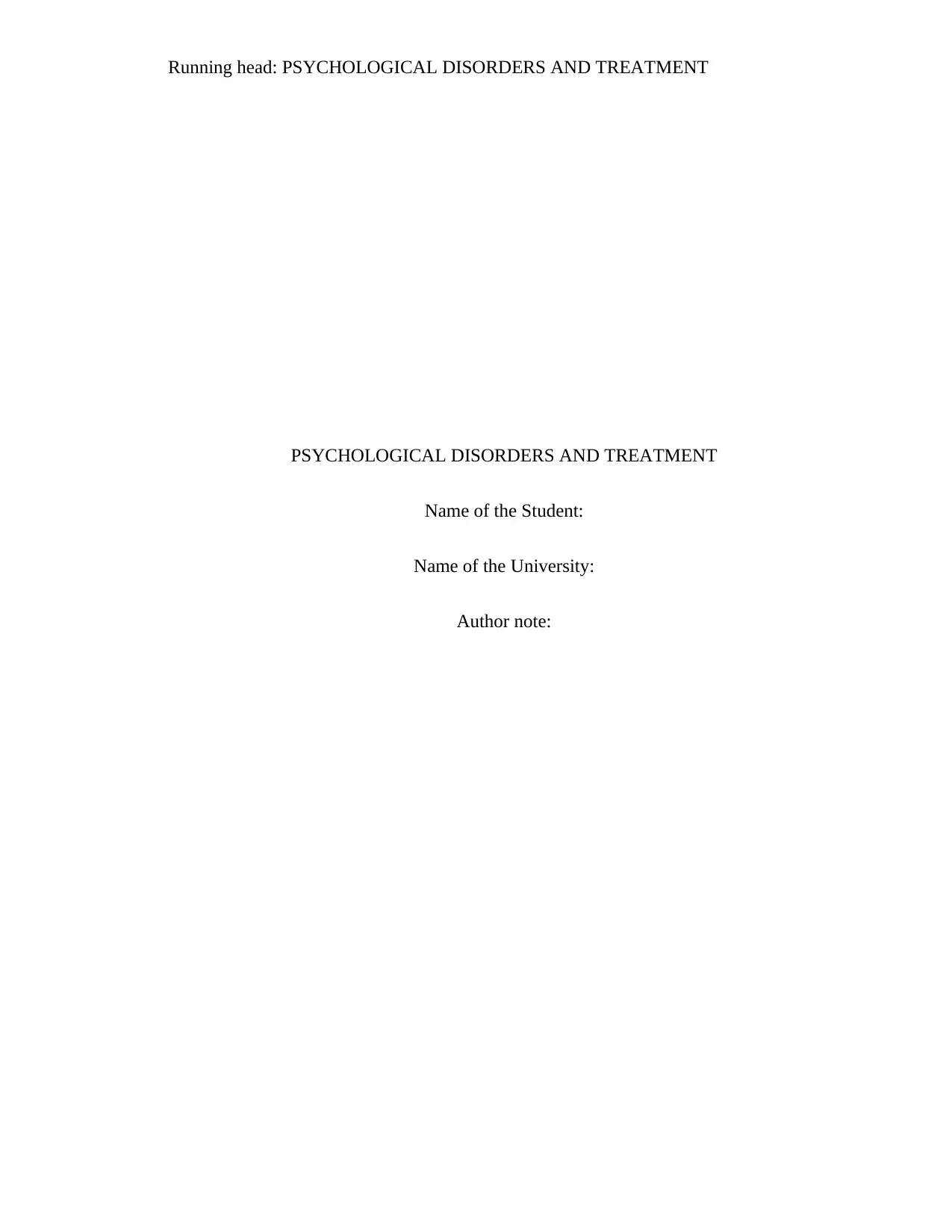
Running head: PSYCHOLOGICAL DISORDERS AND TREATMENT
PSYCHOLOGICAL DISORDERS AND TREATMENT
Name of the Student:
Name of the University:
Author note:
PSYCHOLOGICAL DISORDERS AND TREATMENT
Name of the Student:
Name of the University:
Author note:
Secure Best Marks with AI Grader
Need help grading? Try our AI Grader for instant feedback on your assignments.
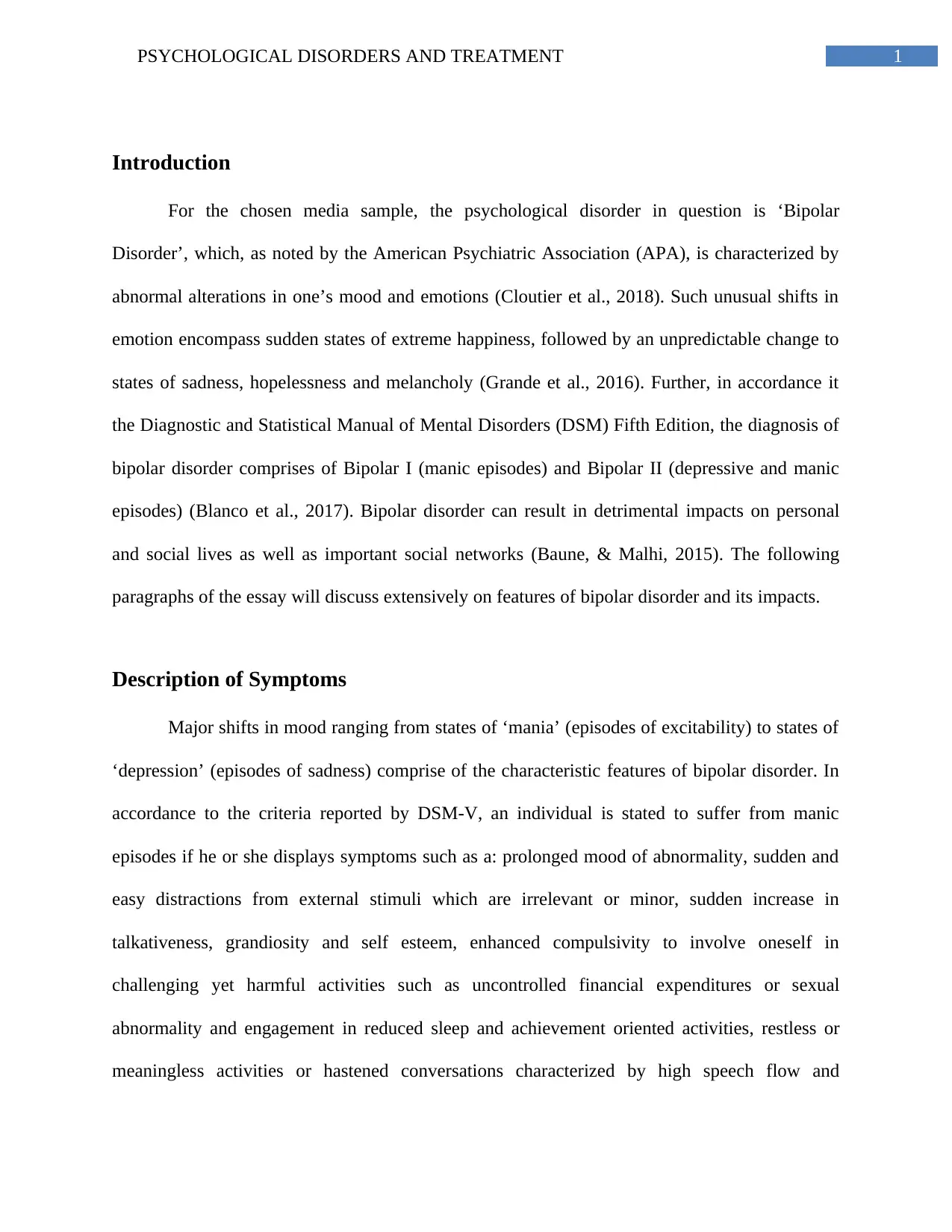
1PSYCHOLOGICAL DISORDERS AND TREATMENT
Introduction
For the chosen media sample, the psychological disorder in question is ‘Bipolar
Disorder’, which, as noted by the American Psychiatric Association (APA), is characterized by
abnormal alterations in one’s mood and emotions (Cloutier et al., 2018). Such unusual shifts in
emotion encompass sudden states of extreme happiness, followed by an unpredictable change to
states of sadness, hopelessness and melancholy (Grande et al., 2016). Further, in accordance it
the Diagnostic and Statistical Manual of Mental Disorders (DSM) Fifth Edition, the diagnosis of
bipolar disorder comprises of Bipolar I (manic episodes) and Bipolar II (depressive and manic
episodes) (Blanco et al., 2017). Bipolar disorder can result in detrimental impacts on personal
and social lives as well as important social networks (Baune, & Malhi, 2015). The following
paragraphs of the essay will discuss extensively on features of bipolar disorder and its impacts.
Description of Symptoms
Major shifts in mood ranging from states of ‘mania’ (episodes of excitability) to states of
‘depression’ (episodes of sadness) comprise of the characteristic features of bipolar disorder. In
accordance to the criteria reported by DSM-V, an individual is stated to suffer from manic
episodes if he or she displays symptoms such as a: prolonged mood of abnormality, sudden and
easy distractions from external stimuli which are irrelevant or minor, sudden increase in
talkativeness, grandiosity and self esteem, enhanced compulsivity to involve oneself in
challenging yet harmful activities such as uncontrolled financial expenditures or sexual
abnormality and engagement in reduced sleep and achievement oriented activities, restless or
meaningless activities or hastened conversations characterized by high speech flow and
Introduction
For the chosen media sample, the psychological disorder in question is ‘Bipolar
Disorder’, which, as noted by the American Psychiatric Association (APA), is characterized by
abnormal alterations in one’s mood and emotions (Cloutier et al., 2018). Such unusual shifts in
emotion encompass sudden states of extreme happiness, followed by an unpredictable change to
states of sadness, hopelessness and melancholy (Grande et al., 2016). Further, in accordance it
the Diagnostic and Statistical Manual of Mental Disorders (DSM) Fifth Edition, the diagnosis of
bipolar disorder comprises of Bipolar I (manic episodes) and Bipolar II (depressive and manic
episodes) (Blanco et al., 2017). Bipolar disorder can result in detrimental impacts on personal
and social lives as well as important social networks (Baune, & Malhi, 2015). The following
paragraphs of the essay will discuss extensively on features of bipolar disorder and its impacts.
Description of Symptoms
Major shifts in mood ranging from states of ‘mania’ (episodes of excitability) to states of
‘depression’ (episodes of sadness) comprise of the characteristic features of bipolar disorder. In
accordance to the criteria reported by DSM-V, an individual is stated to suffer from manic
episodes if he or she displays symptoms such as a: prolonged mood of abnormality, sudden and
easy distractions from external stimuli which are irrelevant or minor, sudden increase in
talkativeness, grandiosity and self esteem, enhanced compulsivity to involve oneself in
challenging yet harmful activities such as uncontrolled financial expenditures or sexual
abnormality and engagement in reduced sleep and achievement oriented activities, restless or
meaningless activities or hastened conversations characterized by high speech flow and

2PSYCHOLOGICAL DISORDERS AND TREATMENT
abruptness (McIntyre et al., 2015). As reported by DSM-V, individuals with episodes of major
depression will present symptoms such as: a prolonged state of sadness and depression
throughout the day or on most day, a lack of interest to engage in once pleasurable activities,
difficulty to sleep or insomnia, feelings of hopelessness, guilt, worthlessness, loss of ability to
engage in adequate decision-making or concentration, frequent preoccupation with suicidal
ideation and loss or gain in appetite (Shim, Woo & Bahk, 2015). An individual may be diagnoses
with bipolar disorders type I if he or she has suffered from a minimum of one manic episode and
may be diagnosed with bipolar disorder type II if she or she has not experienced full manic but
alternative depressive and hypomanic episodes (similar to manic, but decreased symptom
severity) (Solé et al., 2017). In addition, DSM-V also recognizes a milder version of bipolar
known as Cyclothymic disorder where an individual experiences manic and depressive
alterations but with decreased severity (Blanco et al., 2017).
Impact on Life, Family and Friends
Bipolar disorder may result in detrimental physiological impacts on the afflicted
individual in the form of symptoms of fatigue, irritability, weight fluctuations, sexual
dysfunction, muscle pains, arrhythmia, nausea, diarrhea, vomiting and abdominal pain (Malhotra
et al., 2016). According to Baş et al., (2015), in addition to the frequent preoccupation with self
demeaning thoughts and feelings of hopelessness, individuals may be impacted with frequent
states of irritability resulting in conflicts with close friends and family and a loss of enthusiasm
towards life resulting in a desire to suicide or engage in substance abuse. As researched by
Granek et al., (2016), engagement in risky activities characteristic of manic states may result in
financial constraints as well as legal issues for the individual’s family further resulting in
abruptness (McIntyre et al., 2015). As reported by DSM-V, individuals with episodes of major
depression will present symptoms such as: a prolonged state of sadness and depression
throughout the day or on most day, a lack of interest to engage in once pleasurable activities,
difficulty to sleep or insomnia, feelings of hopelessness, guilt, worthlessness, loss of ability to
engage in adequate decision-making or concentration, frequent preoccupation with suicidal
ideation and loss or gain in appetite (Shim, Woo & Bahk, 2015). An individual may be diagnoses
with bipolar disorders type I if he or she has suffered from a minimum of one manic episode and
may be diagnosed with bipolar disorder type II if she or she has not experienced full manic but
alternative depressive and hypomanic episodes (similar to manic, but decreased symptom
severity) (Solé et al., 2017). In addition, DSM-V also recognizes a milder version of bipolar
known as Cyclothymic disorder where an individual experiences manic and depressive
alterations but with decreased severity (Blanco et al., 2017).
Impact on Life, Family and Friends
Bipolar disorder may result in detrimental physiological impacts on the afflicted
individual in the form of symptoms of fatigue, irritability, weight fluctuations, sexual
dysfunction, muscle pains, arrhythmia, nausea, diarrhea, vomiting and abdominal pain (Malhotra
et al., 2016). According to Baş et al., (2015), in addition to the frequent preoccupation with self
demeaning thoughts and feelings of hopelessness, individuals may be impacted with frequent
states of irritability resulting in conflicts with close friends and family and a loss of enthusiasm
towards life resulting in a desire to suicide or engage in substance abuse. As researched by
Granek et al., (2016), engagement in risky activities characteristic of manic states may result in
financial constraints as well as legal issues for the individual’s family further resulting in
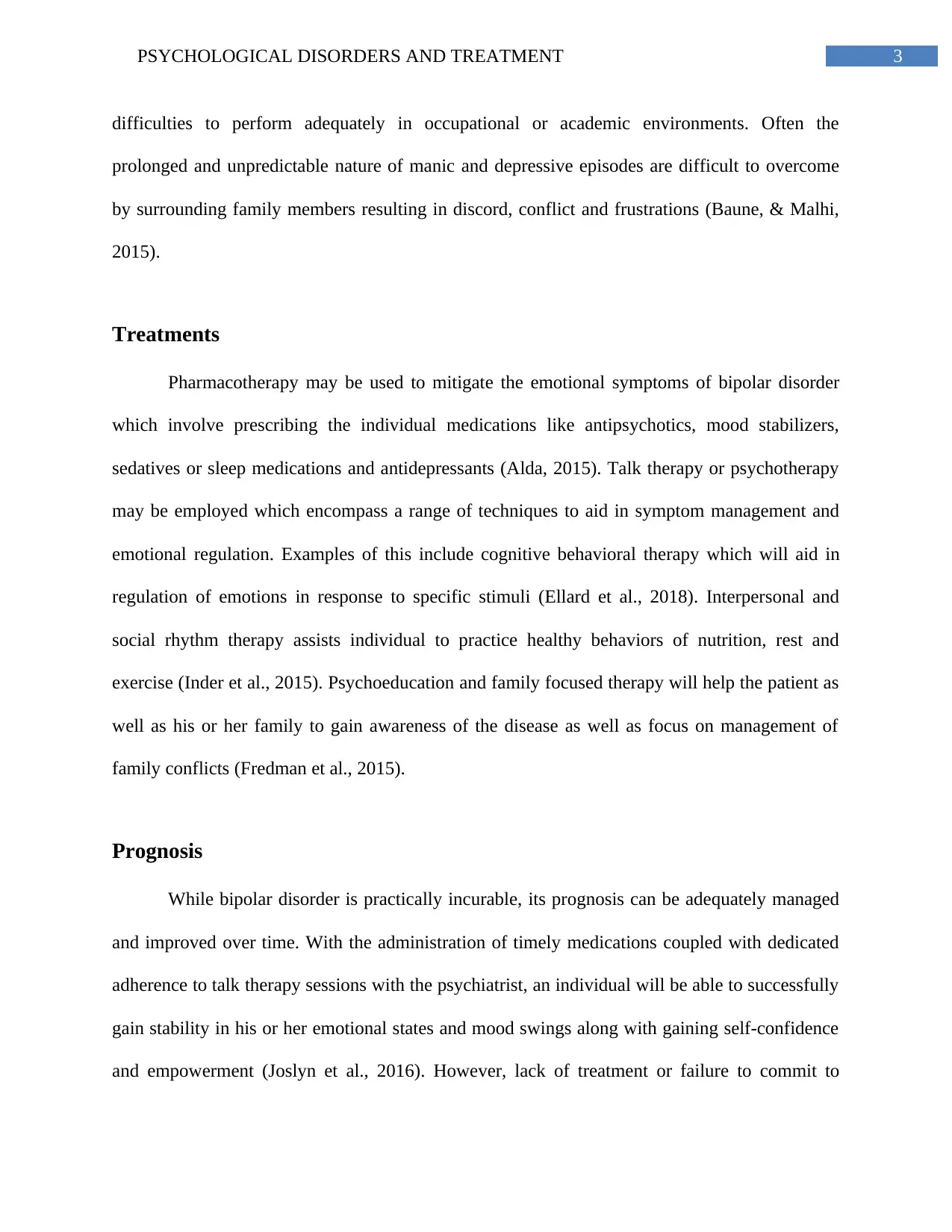
3PSYCHOLOGICAL DISORDERS AND TREATMENT
difficulties to perform adequately in occupational or academic environments. Often the
prolonged and unpredictable nature of manic and depressive episodes are difficult to overcome
by surrounding family members resulting in discord, conflict and frustrations (Baune, & Malhi,
2015).
Treatments
Pharmacotherapy may be used to mitigate the emotional symptoms of bipolar disorder
which involve prescribing the individual medications like antipsychotics, mood stabilizers,
sedatives or sleep medications and antidepressants (Alda, 2015). Talk therapy or psychotherapy
may be employed which encompass a range of techniques to aid in symptom management and
emotional regulation. Examples of this include cognitive behavioral therapy which will aid in
regulation of emotions in response to specific stimuli (Ellard et al., 2018). Interpersonal and
social rhythm therapy assists individual to practice healthy behaviors of nutrition, rest and
exercise (Inder et al., 2015). Psychoeducation and family focused therapy will help the patient as
well as his or her family to gain awareness of the disease as well as focus on management of
family conflicts (Fredman et al., 2015).
Prognosis
While bipolar disorder is practically incurable, its prognosis can be adequately managed
and improved over time. With the administration of timely medications coupled with dedicated
adherence to talk therapy sessions with the psychiatrist, an individual will be able to successfully
gain stability in his or her emotional states and mood swings along with gaining self-confidence
and empowerment (Joslyn et al., 2016). However, lack of treatment or failure to commit to
difficulties to perform adequately in occupational or academic environments. Often the
prolonged and unpredictable nature of manic and depressive episodes are difficult to overcome
by surrounding family members resulting in discord, conflict and frustrations (Baune, & Malhi,
2015).
Treatments
Pharmacotherapy may be used to mitigate the emotional symptoms of bipolar disorder
which involve prescribing the individual medications like antipsychotics, mood stabilizers,
sedatives or sleep medications and antidepressants (Alda, 2015). Talk therapy or psychotherapy
may be employed which encompass a range of techniques to aid in symptom management and
emotional regulation. Examples of this include cognitive behavioral therapy which will aid in
regulation of emotions in response to specific stimuli (Ellard et al., 2018). Interpersonal and
social rhythm therapy assists individual to practice healthy behaviors of nutrition, rest and
exercise (Inder et al., 2015). Psychoeducation and family focused therapy will help the patient as
well as his or her family to gain awareness of the disease as well as focus on management of
family conflicts (Fredman et al., 2015).
Prognosis
While bipolar disorder is practically incurable, its prognosis can be adequately managed
and improved over time. With the administration of timely medications coupled with dedicated
adherence to talk therapy sessions with the psychiatrist, an individual will be able to successfully
gain stability in his or her emotional states and mood swings along with gaining self-confidence
and empowerment (Joslyn et al., 2016). However, lack of treatment or failure to commit to
Secure Best Marks with AI Grader
Need help grading? Try our AI Grader for instant feedback on your assignments.

4PSYCHOLOGICAL DISORDERS AND TREATMENT
treatment guidelines may result in worsening of symptoms and emergence of suicide ideation
(Post et al., 2015).
treatment guidelines may result in worsening of symptoms and emergence of suicide ideation
(Post et al., 2015).
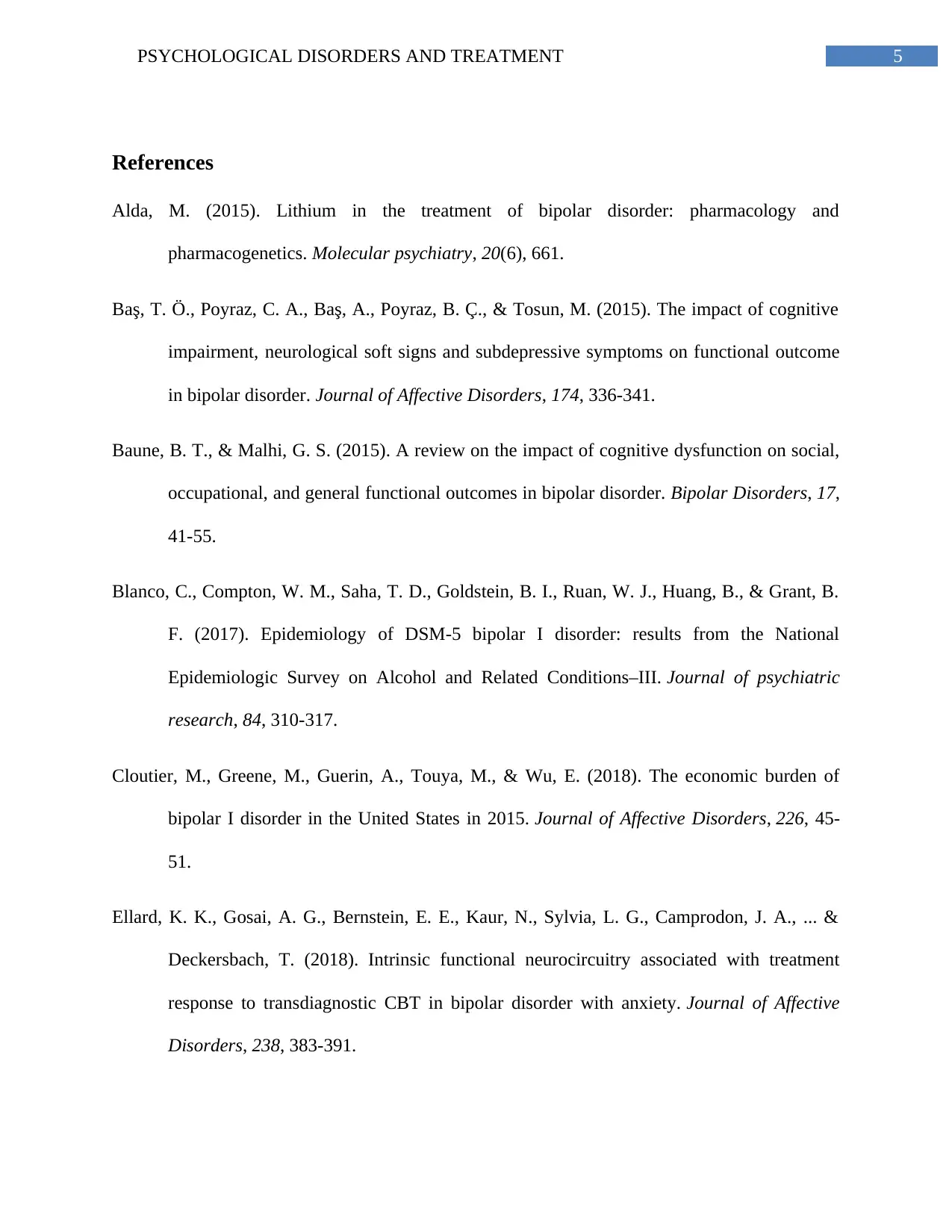
5PSYCHOLOGICAL DISORDERS AND TREATMENT
References
Alda, M. (2015). Lithium in the treatment of bipolar disorder: pharmacology and
pharmacogenetics. Molecular psychiatry, 20(6), 661.
Baş, T. Ö., Poyraz, C. A., Baş, A., Poyraz, B. Ç., & Tosun, M. (2015). The impact of cognitive
impairment, neurological soft signs and subdepressive symptoms on functional outcome
in bipolar disorder. Journal of Affective Disorders, 174, 336-341.
Baune, B. T., & Malhi, G. S. (2015). A review on the impact of cognitive dysfunction on social,
occupational, and general functional outcomes in bipolar disorder. Bipolar Disorders, 17,
41-55.
Blanco, C., Compton, W. M., Saha, T. D., Goldstein, B. I., Ruan, W. J., Huang, B., & Grant, B.
F. (2017). Epidemiology of DSM-5 bipolar I disorder: results from the National
Epidemiologic Survey on Alcohol and Related Conditions–III. Journal of psychiatric
research, 84, 310-317.
Cloutier, M., Greene, M., Guerin, A., Touya, M., & Wu, E. (2018). The economic burden of
bipolar I disorder in the United States in 2015. Journal of Affective Disorders, 226, 45-
51.
Ellard, K. K., Gosai, A. G., Bernstein, E. E., Kaur, N., Sylvia, L. G., Camprodon, J. A., ... &
Deckersbach, T. (2018). Intrinsic functional neurocircuitry associated with treatment
response to transdiagnostic CBT in bipolar disorder with anxiety. Journal of Affective
Disorders, 238, 383-391.
References
Alda, M. (2015). Lithium in the treatment of bipolar disorder: pharmacology and
pharmacogenetics. Molecular psychiatry, 20(6), 661.
Baş, T. Ö., Poyraz, C. A., Baş, A., Poyraz, B. Ç., & Tosun, M. (2015). The impact of cognitive
impairment, neurological soft signs and subdepressive symptoms on functional outcome
in bipolar disorder. Journal of Affective Disorders, 174, 336-341.
Baune, B. T., & Malhi, G. S. (2015). A review on the impact of cognitive dysfunction on social,
occupational, and general functional outcomes in bipolar disorder. Bipolar Disorders, 17,
41-55.
Blanco, C., Compton, W. M., Saha, T. D., Goldstein, B. I., Ruan, W. J., Huang, B., & Grant, B.
F. (2017). Epidemiology of DSM-5 bipolar I disorder: results from the National
Epidemiologic Survey on Alcohol and Related Conditions–III. Journal of psychiatric
research, 84, 310-317.
Cloutier, M., Greene, M., Guerin, A., Touya, M., & Wu, E. (2018). The economic burden of
bipolar I disorder in the United States in 2015. Journal of Affective Disorders, 226, 45-
51.
Ellard, K. K., Gosai, A. G., Bernstein, E. E., Kaur, N., Sylvia, L. G., Camprodon, J. A., ... &
Deckersbach, T. (2018). Intrinsic functional neurocircuitry associated with treatment
response to transdiagnostic CBT in bipolar disorder with anxiety. Journal of Affective
Disorders, 238, 383-391.
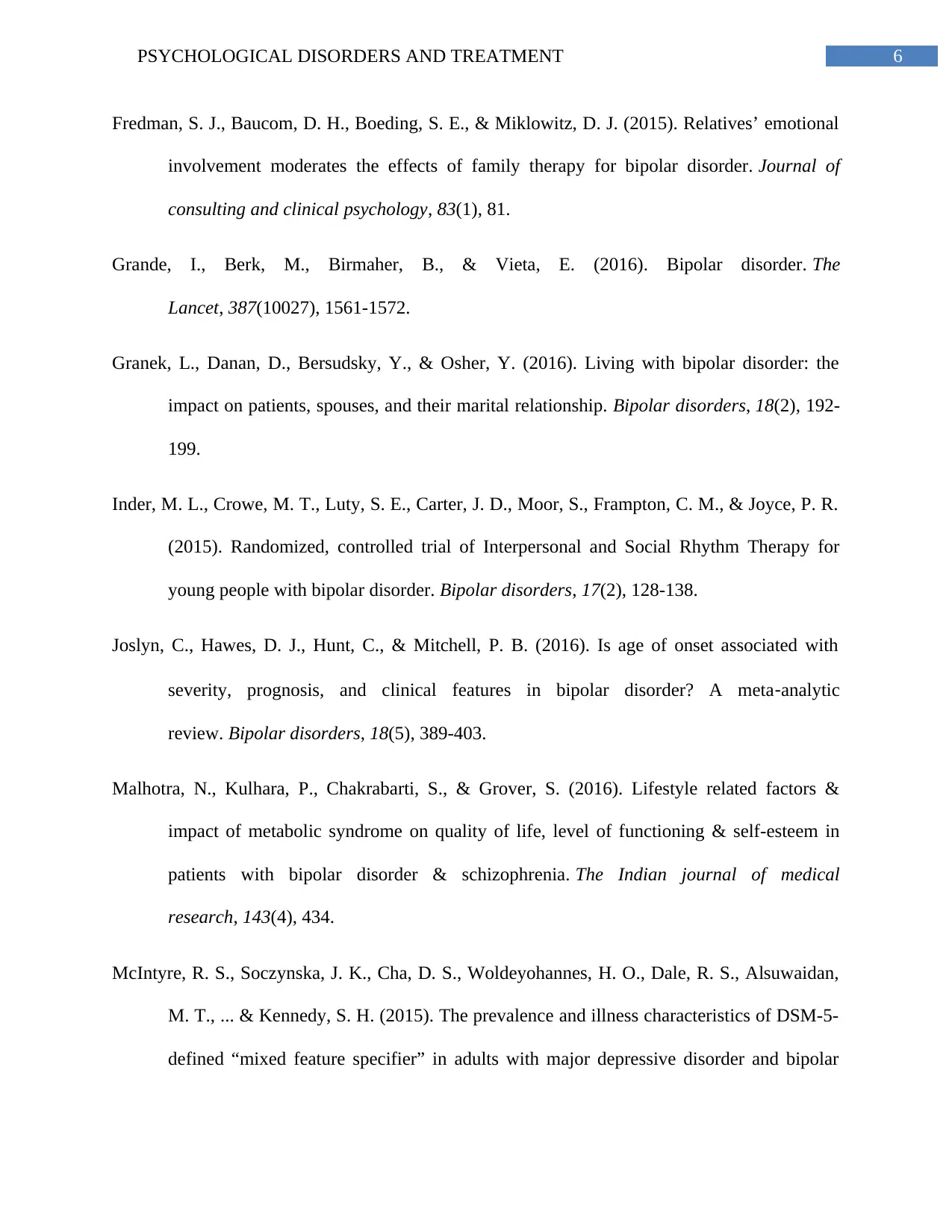
6PSYCHOLOGICAL DISORDERS AND TREATMENT
Fredman, S. J., Baucom, D. H., Boeding, S. E., & Miklowitz, D. J. (2015). Relatives’ emotional
involvement moderates the effects of family therapy for bipolar disorder. Journal of
consulting and clinical psychology, 83(1), 81.
Grande, I., Berk, M., Birmaher, B., & Vieta, E. (2016). Bipolar disorder. The
Lancet, 387(10027), 1561-1572.
Granek, L., Danan, D., Bersudsky, Y., & Osher, Y. (2016). Living with bipolar disorder: the
impact on patients, spouses, and their marital relationship. Bipolar disorders, 18(2), 192-
199.
Inder, M. L., Crowe, M. T., Luty, S. E., Carter, J. D., Moor, S., Frampton, C. M., & Joyce, P. R.
(2015). Randomized, controlled trial of Interpersonal and Social Rhythm Therapy for
young people with bipolar disorder. Bipolar disorders, 17(2), 128-138.
Joslyn, C., Hawes, D. J., Hunt, C., & Mitchell, P. B. (2016). Is age of onset associated with
severity, prognosis, and clinical features in bipolar disorder? A meta‐analytic
review. Bipolar disorders, 18(5), 389-403.
Malhotra, N., Kulhara, P., Chakrabarti, S., & Grover, S. (2016). Lifestyle related factors &
impact of metabolic syndrome on quality of life, level of functioning & self-esteem in
patients with bipolar disorder & schizophrenia. The Indian journal of medical
research, 143(4), 434.
McIntyre, R. S., Soczynska, J. K., Cha, D. S., Woldeyohannes, H. O., Dale, R. S., Alsuwaidan,
M. T., ... & Kennedy, S. H. (2015). The prevalence and illness characteristics of DSM-5-
defined “mixed feature specifier” in adults with major depressive disorder and bipolar
Fredman, S. J., Baucom, D. H., Boeding, S. E., & Miklowitz, D. J. (2015). Relatives’ emotional
involvement moderates the effects of family therapy for bipolar disorder. Journal of
consulting and clinical psychology, 83(1), 81.
Grande, I., Berk, M., Birmaher, B., & Vieta, E. (2016). Bipolar disorder. The
Lancet, 387(10027), 1561-1572.
Granek, L., Danan, D., Bersudsky, Y., & Osher, Y. (2016). Living with bipolar disorder: the
impact on patients, spouses, and their marital relationship. Bipolar disorders, 18(2), 192-
199.
Inder, M. L., Crowe, M. T., Luty, S. E., Carter, J. D., Moor, S., Frampton, C. M., & Joyce, P. R.
(2015). Randomized, controlled trial of Interpersonal and Social Rhythm Therapy for
young people with bipolar disorder. Bipolar disorders, 17(2), 128-138.
Joslyn, C., Hawes, D. J., Hunt, C., & Mitchell, P. B. (2016). Is age of onset associated with
severity, prognosis, and clinical features in bipolar disorder? A meta‐analytic
review. Bipolar disorders, 18(5), 389-403.
Malhotra, N., Kulhara, P., Chakrabarti, S., & Grover, S. (2016). Lifestyle related factors &
impact of metabolic syndrome on quality of life, level of functioning & self-esteem in
patients with bipolar disorder & schizophrenia. The Indian journal of medical
research, 143(4), 434.
McIntyre, R. S., Soczynska, J. K., Cha, D. S., Woldeyohannes, H. O., Dale, R. S., Alsuwaidan,
M. T., ... & Kennedy, S. H. (2015). The prevalence and illness characteristics of DSM-5-
defined “mixed feature specifier” in adults with major depressive disorder and bipolar
Paraphrase This Document
Need a fresh take? Get an instant paraphrase of this document with our AI Paraphraser
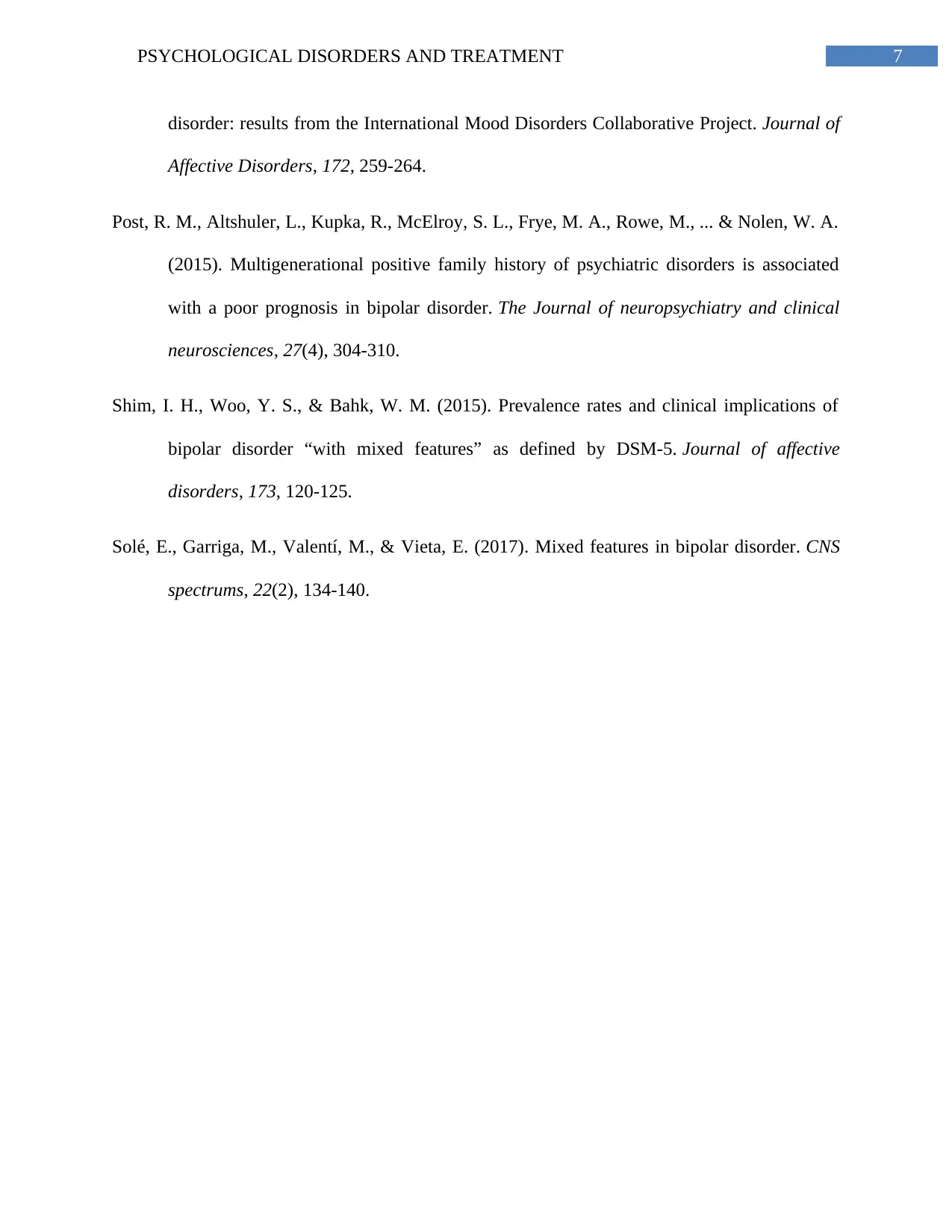
7PSYCHOLOGICAL DISORDERS AND TREATMENT
disorder: results from the International Mood Disorders Collaborative Project. Journal of
Affective Disorders, 172, 259-264.
Post, R. M., Altshuler, L., Kupka, R., McElroy, S. L., Frye, M. A., Rowe, M., ... & Nolen, W. A.
(2015). Multigenerational positive family history of psychiatric disorders is associated
with a poor prognosis in bipolar disorder. The Journal of neuropsychiatry and clinical
neurosciences, 27(4), 304-310.
Shim, I. H., Woo, Y. S., & Bahk, W. M. (2015). Prevalence rates and clinical implications of
bipolar disorder “with mixed features” as defined by DSM-5. Journal of affective
disorders, 173, 120-125.
Solé, E., Garriga, M., Valentí, M., & Vieta, E. (2017). Mixed features in bipolar disorder. CNS
spectrums, 22(2), 134-140.
disorder: results from the International Mood Disorders Collaborative Project. Journal of
Affective Disorders, 172, 259-264.
Post, R. M., Altshuler, L., Kupka, R., McElroy, S. L., Frye, M. A., Rowe, M., ... & Nolen, W. A.
(2015). Multigenerational positive family history of psychiatric disorders is associated
with a poor prognosis in bipolar disorder. The Journal of neuropsychiatry and clinical
neurosciences, 27(4), 304-310.
Shim, I. H., Woo, Y. S., & Bahk, W. M. (2015). Prevalence rates and clinical implications of
bipolar disorder “with mixed features” as defined by DSM-5. Journal of affective
disorders, 173, 120-125.
Solé, E., Garriga, M., Valentí, M., & Vieta, E. (2017). Mixed features in bipolar disorder. CNS
spectrums, 22(2), 134-140.
1 out of 8
Related Documents
Your All-in-One AI-Powered Toolkit for Academic Success.
+13062052269
info@desklib.com
Available 24*7 on WhatsApp / Email
![[object Object]](/_next/static/media/star-bottom.7253800d.svg)
Unlock your academic potential
© 2024 | Zucol Services PVT LTD | All rights reserved.




